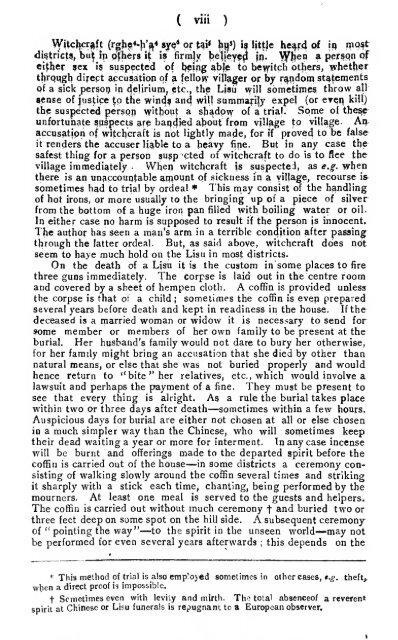this( viii )\Vitchcraft (rghe>h'a« sye* or tai» hjj») is little he^rd <strong>of</strong> jflmostdistrict?, bu'$ Jp pfhers it is ifirmjy belieyep: jjj. \yhen a pprsqo <strong>of</strong>ei<strong>the</strong>r sex is suspected <strong>of</strong> being able to bewitch o<strong>the</strong>rs, whe<strong>the</strong>rthrough direct accusation <strong>of</strong> a fellow villager or by random statements<strong>of</strong> a sick person irj delirium, etc., <strong>the</strong> Ljsu will sometimes throw allBense <strong>of</strong> justipe tp <strong>the</strong> winds and W 'U summarily expel (or eveq kill)<strong>the</strong> suspected person without a shadow <strong>of</strong> a triaj. Some <strong>of</strong> <strong>the</strong>seunfortunate suspects are baqdied about from village to village. Anaccusation <strong>of</strong> witchcraft is not lightly made, for if proved to be falseit renders <strong>the</strong> accuser liable to a heavy fine. But in any case <strong>the</strong>safest thing for a person suspected <strong>of</strong> witchcraft to do is to flee <strong>the</strong>village immediately When witchcraft - |s suspected, as e.g. when<strong>the</strong>re is an unaccountable amount <strong>of</strong> sickness in a village, recourse is^sometimes hqd to trial by ordeal * This may consist <strong>of</strong> <strong>the</strong> handling<strong>of</strong> hot irons, or more usually to <strong>the</strong> bringing up <strong>of</strong> a piece <strong>of</strong> silverfrom <strong>the</strong> bottom <strong>of</strong> a huge iroq pan filled with boiling water or oil.In ei<strong>the</strong>r case no harm is supposed to result if <strong>the</strong> person is innocent.The author has seen a man's arm in a terrible condition after passingthrough <strong>the</strong> latter ordeal. But, as said above, witchcraft does notseem to have much hold on <strong>the</strong> <strong>Lisu</strong> in most districts.On <strong>the</strong> death <strong>of</strong> a <strong>Lisu</strong> it is <strong>the</strong> custom in some places to firethree guns immediately. 'J'he corpse is laid out in <strong>the</strong> centre roomand covered by a sheet <strong>of</strong> hempen cloth. A c<strong>of</strong>fin is provided unless<strong>the</strong> corpse is that <strong>of</strong> a child ; sometimes <strong>the</strong> c<strong>of</strong>fin is evep preparedseveral years before death and kept in readiness in <strong>the</strong> house. If <strong>the</strong>deceased is a married woman or widow it is necessary to send forsome member or members <strong>of</strong> her own family to be present at <strong>the</strong>burial. Her husband's family would not dare to bury her o<strong>the</strong>rwise,for her family mjght bring an accusation that she died by o<strong>the</strong>r thannatural means, or else that she was not buried properly and wouldhence return to "bite "her relatives, etc., which would involve alawsuit and perhaps <strong>the</strong> payment <strong>of</strong> a fine. They must be present tosee that every thing is alright. As a rule <strong>the</strong> burial takes placewithin two or three days after death—sometimes within a few hours.Auspicious days for burial are ei<strong>the</strong>r not chosen at all or else chosenin a much simpler way than <strong>the</strong> Chinese, who will sometimes keep<strong>the</strong>ir dead waiting a year or more for interment. In any case incensewill be burnt and <strong>of</strong>ferings made to <strong>the</strong> departed spirit before <strong>the</strong>c<strong>of</strong>fin is carried out <strong>of</strong> <strong>the</strong> house—in some districts a ceremony consisting<strong>of</strong> walking slowly around <strong>the</strong> c<strong>of</strong>fin several times and strikingit sharply with a stick each time, chanting, being performed by <strong>the</strong>mourners. At least one meal is served to <strong>the</strong> guests and helpers.The c<strong>of</strong>fin is carried out without much ceremony f and buried two orthree feet deep on some spot on <strong>the</strong> hill side. A subsequent ceremony<strong>of</strong> " pointing <strong>the</strong> way"—to <strong>the</strong> spirit in <strong>the</strong> unseen world—may notbe performed for even several years afterwards; depends on <strong>the</strong>* This method <strong>of</strong> trial is also employed sometimes in o<strong>the</strong>r cases, t.g. <strong>the</strong>ft,,when a direct pro<strong>of</strong> is impossible.t Sometimes even with levity and mirth. The total absence<strong>of</strong> a reverentspirit at Chinese or <strong>Lisu</strong> funerals is repugnant to a European observer.
( ix )ability or o<strong>the</strong>rwise <strong>of</strong> tie survivors to provide <strong>the</strong> means, for <strong>the</strong>sacrificial ceremonies involve <strong>the</strong> expenditure <strong>of</strong> a considerable sum<strong>of</strong> money. Cremation is practised only in cases where <strong>the</strong>re isconsidered to be pollution, death being caused by e_vfil spiritualinfluences.< vBetrothal and marriage ceremonies vary considerably in differentdistricts. When a man wishes to get a bride for his son, who may beanything up to about twenty years <strong>of</strong> age, he has first to find amiddleman to carry his proposal to <strong>the</strong> girl's family. If consent isobtained a small deposit <strong>of</strong> a rupee or two is given to <strong>the</strong> girl'sparents, a mutual bow is made and <strong>the</strong> betrothal is accomplished.The boy's own wishes in <strong>the</strong> matter are seldom consulted, and <strong>the</strong>girl's never. Indeed it would not be easy, because <strong>of</strong> <strong>the</strong> youngpeople's bashfulness, to get an expression <strong>of</strong> opinion out <strong>of</strong> ei<strong>the</strong>r <strong>of</strong><strong>the</strong>m, even if any <strong>Lisu</strong> parent were to try to do so. The bridal priceis fixed at <strong>the</strong> time <strong>of</strong> <strong>the</strong> betrothal, and will usually be from Rs. 50to Rs. 150. Sometimes an exchange will be made between tw<strong>of</strong>amilies, a man giving his daughter to ano<strong>the</strong>r's son in exchange for<strong>the</strong> Iatter's daughter for his own son : this arrangement cancels <strong>the</strong>bridal prices and none is given by ei<strong>the</strong>r party. In most cases a<strong>Lisu</strong> will require <strong>the</strong> same sum <strong>of</strong> money for his daughter that hehimself gave for his wife, her mo<strong>the</strong>r. This is <strong>of</strong>ten tantamount toan exchange, for <strong>the</strong> custom in most districts is that <strong>the</strong> girl, or at anyrate one girl in <strong>the</strong> family—be given back in marriage to her mo<strong>the</strong>r'speople. But she must never be given to a member <strong>of</strong> her own clan,even if <strong>the</strong> relationship is too remote to be traced. Indeed if two<strong>Lisu</strong> families live in widely separated districts between which <strong>the</strong>re isno intercommunication, so that it may be safely inferred that<strong>the</strong>y are not related at all, <strong>the</strong>y must not intermarry if <strong>the</strong>y happen tohave <strong>the</strong> same clan surname. Possibly this custom also is to be putdown to Chinese influence, for <strong>the</strong> Chinese are equally strict in thisregard. Yet a <strong>Lisu</strong> may marry his fa<strong>the</strong>r's sister's daughter * withoutany thought <strong>of</strong> inconsistency. £-g- a <strong>Lisu</strong> Macdonald will give histsister in marriage to a <strong>Lisu</strong> Macgregor. His son may marry adaughter <strong>of</strong> <strong>the</strong> latter marriage, because she is a Macgregor and hea Macdonald. That such a union is undesirable from <strong>the</strong> standpoint<strong>of</strong> consanguinity does not occur to him, yet by some peculiar mentalkink he would stoutly object to marrying his son to a Miss Macdonald,even though <strong>the</strong> actual relationship might be nil, because he and sheare both Macdonalds. In some districts certain clans are said tobe related to certain o<strong>the</strong>r clans, and <strong>the</strong>y are not supposed tointermarry. But <strong>the</strong>re is no arrangement whereby a certain clan ispermanent parent-in-law to ano<strong>the</strong>r clan, as <strong>the</strong>re seems to be amongsome tribes <strong>of</strong> Kachins.Betrothals are binding and cannot be broken <strong>of</strong>f at will. Shouldei<strong>the</strong>r party break <strong>the</strong> contract without <strong>the</strong> consent <strong>of</strong> <strong>the</strong> o<strong>the</strong>r aheavy fine is imposed ;cases sometimes occur, however, where abetrothal is cancelled by consent <strong>of</strong> both parties.* There are cases <strong>of</strong> <strong>Lisu</strong> rrmrrying <strong>the</strong>ir own fa<strong>the</strong>r's sisters, but this is rareand looked down upon.
- Page 1 and 2: WasonPL4001L7F84
- Page 3 and 4: Cornell University LibraryPL 4001.L
- Page 7 and 8: HANDBOOKOF THELISU (YAWYIN) LANGUAG
- Page 9 and 10: NOTE ON THE ORIGIN, DISTRIBUTION,CU
- Page 11 and 12: ( v )displeasure by unwittingly off
- Page 13: ( vii ),is even a small colony of L
- Page 17: ( xi )elope. Nor do they always " l
- Page 20: ( a )vowel. There are few polysylla
- Page 23 and 24: are, however, changed as follows: t
- Page 25 and 26: ( 7 )Often the expletives nya* (Kac
- Page 27 and 28: i( 9 )(f) L&cative.-^Bath -the idea
- Page 29 and 30: (II)Dtt 3 is sometimes added to adj
- Page 31 and 32: ( 13 )The derrionstrative pronouns
- Page 33 and 34: ( >5 )Similarly "this sort," " that
- Page 35 and 36: •hwaI i7)Mother and son'Grandfath
- Page 37 and 38: ( 19 )enumerated as so many fa.*-lt
- Page 39 and 40: ( 21 )Another construction is to us
- Page 41 and 42: ( '3 )The more the more is expresse
- Page 43 and 44: ( *5 )(c) The indefinite perfect is
- Page 45 and 46: ( a7)(&) In a simple question expec
- Page 47 and 48: ( 29 )different shades of meaning.
- Page 49 and 50: ( 3» )Hckt* in the positive = may;
- Page 51 and 52: ( 33 )The use of /«* to express th
- Page 53 and 54: i< 35 !paper, garment, or even the
- Page 55 and 56: ExamfUs ;—( 37 )a s -mrgh' 3 hti*
- Page 57 and 58: ( 39 )» c '' '•,It would be appr
- Page 59 and 60: ( 4i )hpu* nya 3 ma" jaw*; gaw*-le
- Page 61 and 62: ( 43 )baw 6 -law 3 dza s ma s srghe
- Page 63 and 64: ( 45 )The idea of totality is very
- Page 65 and 66:
,( 4.7 )The word ia 1 (in some dist
- Page 67 and 68:
( 49 )yi'-wa* hchaw 5 yi'-wa s ti'-
- Page 69 and 70:
( 5» )(25) " There is plenty of ti
- Page 71 and 72:
i( 53 )dent verb, and seems to be l
- Page 73 and 74:
( 55 )(39) Desire to do a thing (Ka
- Page 75 and 76:
( 57 )(48) To " last long" is expre
- Page 77 and 78:
( 59 ){i)Where dummy words are used
- Page 79 and 80:
( 61 )The other moons take the ordi
- Page 81 and 82:
( 63 )(and the information would pr
- Page 83 and 84:
!( 65 )Grandson = Ii'-pa*.Great-gra
- Page 85:
( 67 )M scribe " —usually deal in
- Page 88 and 89:
( 7° )After {prep.) ...AfternoonAg
- Page 90 and 91:
Bear, to (give birth to)( 7» )
- Page 92 and 93:
BridgeBridle ...Bright, to bePring,
- Page 94 and 95:
( 76 )Collect, to (assemble)Collide
- Page 96 and 97:
Descend, to(, 78 )
- Page 98 and 99:
( 8o )End ;extremity
- Page 100 and 101:
( 83 )Fish (rotten, Burmese ngafi)
- Page 102 and 103:
( 84 )Graze, to ... ... shi 1 dza?G
- Page 104 and 105:
( 86 )tIdleIdolIfIgnorant, to be ..
- Page 106 and 107:
88 )Kitten, a ... ...Knead, tot..Kn
- Page 108 and 109:
(9o )Low, to be . ...„ to (of cat
- Page 110 and 111:
( 9» )Naked, to beName, aNarrateNa
- Page 112 and 113:
( 94 )ParentsPart, a, of,, to (take
- Page 114 and 115:
( 96 )Proprietor; ownerProtect, toP
- Page 116 and 117:
Riches( 98 )
- Page 118 and 119:
( ioo)Shoot, toShore, theShort {adj
- Page 120 and 121:
( ica )Stallion, a ....Stammer, to
- Page 122 and 123:
Three*( »°4 )
- Page 124 and 125:
Vapour ...(io6 )
- Page 126:
( io8 )World; earth ...Worm, aWorsh
















